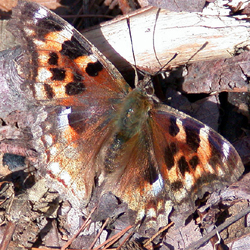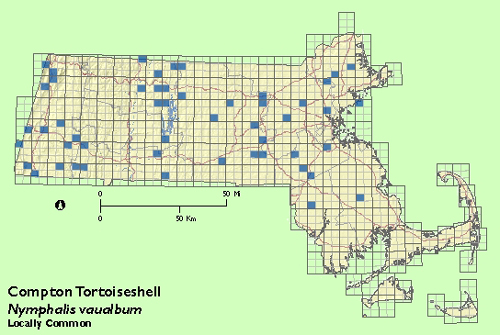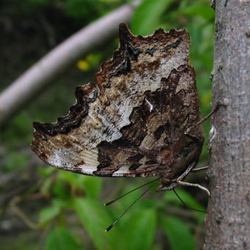Butterfly Atlas
Find a Butterfly
Compton Tortoiseshell
Nymphalis vau-album
Named
Denis and Schiffermuller, 1775

Taxonomy & Nomenclature
Referred to in earlier literature as Nymphalis j-album. The eastern North American subspecies is now N. vau-album j-album (Boisduval and Leconte), 1833.
Identification
Wingspan: 2 1/2 - 2 7/8". Superficially similar to the anglewings, but readily distinguished by its generally larger size (largest Question Marks barely reach wingspan of smallest Comptons), its bold black spotting pattern on the forewing above, and by the presence of two white patches on the upper wing surfaces: a small one near the tip of the forewing and a larger one at the upper edge of the hindwing.
Distribution
Holarctic. Occurs as a permanent resident throughout the Northern Hemisphere in the boreal (Canadian) zone, but apparently does not follow this "life zone" south at higher elevations as do many species. In North America its permanent range adheres closely to its preferred northern deciduous forest habitat from coastal British Columbia south in the Rockies (only as far as northern Idaho) east along the Canadian-U.S. border to Nova Scotia and northern New England. It is a mobile species, appears frequently (though irregularly) in a wide zone both to the north and south of its permanent range, and has occurred as a vagrant as far south as central Florida. In New England its permanent breeding range lies to the north of about 44 degrees north latitude, i.e. northern New Hampshire and Vermont northward.
Status in Massachusetts
An irregular visitor from the North which periodically establishes temporary breeding populations. These may persist for a decade or more, following which the species may be absent for many years. It has been more persistent and widespread in southern New England since the 1970‘s than previously. It was found every year and was relatively common during the Atlas project (1986-90). It unquestionably hibernates and aestivates in the state (specimens found in buildings, etc.), and summer and fall records in Massachusetts presumably represent both local individuals - the progeny of the hibernating/aestivating generations - and emigrants from the species permanent range to the North. Apparently, climate related factors work against successful reproduction this far south so that breeding populations gradually die out. When these extinctions coincide with years of low emigration, the species will be absent for at least a year since no hibernating generation is then produced. Widely and evenly distributed inland; generally rarer along the coast, especially the eastern extremities of Cape Ann, Cape Cod and the islands. However, see Notes, below, for a remarkable Nantucket occurrence. Maxima: 3, Lincoln (Middlesex Co.), 29 March 1989; "hundreds", Nantucket (Dukes Co.), 11 September 1874, S. Scudder.

Flight Period in Massachusetts
This species has one of the longest flight periods of any butterfly in Massachusetts, regularly emerging in March before its close relative the Mourning Cloak and remaining active until late in the fall. When present, flies from late March through May (emerging hibernators), in July (aestivating generation) and finally September through October (aestivators [and off-spring of aestivators?] which then overwinter). Extreme dates: 12 February (temperature 33 degrees F.!), S.Scudder; 16 March 1989, Rehoboth (Bristol Co.), K. Anderson; 6 November 1988, Sterling (Worcester Co.), S. Selkow.
Larval Food Plants
A variety of tree species, especially willows, poplars, birches, and elms; in Europe also on beech (Fagus sylvatica). Massachusetts species from which recorded: Quaking Aspen (Populus tremuloides), American Elm (Ulmus americana), White Birch (Betula papyrifera), Gray Birch (B. populifolia), Black Birch (B. lenta), and Yellow Birch (B. allegheniensis[lutea]); species of willows not recorded.
Adult Food sources
This species‘ fondness for sap and fruit juices is widely recorded ("I even saw them drinking spruce beer from the old apple-woman‘s kegs in the Upper Town Market, Quebec..." (Bowles, 1912). It also feeds at wet soils and cow and horse dung. Visits flowers infrequently; it has been seen on willow catkins in early spring. MBAP workers recorded only a single instance of nectaring, at Red Maple blossoms.

Habitat
Northern hardwood forests and boreal second growth where its food plants abound. Open wooded areas, clearings and along forest-lined roads. In Massachusetts during periods of abundance it is commonly seen in wooded suburbs, where houses provide ideal hibernating spaces.
Life Cycle
EGG: A yellow dome with c. eight prominent vertical ridges converging in a depression at the top. OVIPOSITION: Small clusters of eggs are deposited on leaves of the food plant. LARVA: Largely light green with paler spots and stripes and covered with shiny black bristly spines; feeds in aggregations. CHRYSALIS: Variously described as whitish, green, tan or reddish with many darker markings and areas of gold; numerous spines along the back and two horns on the head. PUPAL STAGE: Pupation occurs in mid- to late June (also aestivators in fall?). Duration: about two weeks. OVERWINTERING STAGE: Adults take refuge under tree bark, in rock crevices and in buildings, singly or in aggregations. Proctor (1976) describes mass winter roost.
Like other tortoiseshells, anglewings and Vanessas, male Comptons perch in prominent positions and await passing females. Mating and egg laying occur mainly late March through May (and in fall-aestivators?). The single summer brood begins emerging around early July then aestivates (found in barn in Sturbridge in August(Schweitzer, pers. comm.)
The species is known to roost for the night in small aggregations on tree trunks. Emigrations from the permanent range in the North apparently occur in late summer and fall. These are seldom spectacular; however, see Notes.
Notes
The emigrations of Compton Tortoiseshell are normally relatively inconspicuous; however, Samuel Scudder (1874) records this remarkable exception: "Butterflies are not generally known to fly by night, but...on a cloudy and unusually warm night in September (11th), butterflies of this species (N. vau-album) flew into the lantern of Sankaty Head Light, Nantucket, a powerful flashlight, in such numbers as to give the keepers much trouble by obstructing the flow of oil in the lamp...Yet in a five year summer residence and collecting there I had never seen the butterfly" (Scudder, 1889)
Schweitzer (pers. comm.) notes that this species readily comes to sugar baits in March and July.
This can be a very hard butterfly to catch. No one has described its powers of escape better than Fyles (1885) who notes that "it dashes away with a speed that sets pursuit at defiance".
Account Author
Chris Leahy



